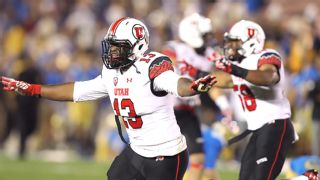|
There is a literal and figurative parallel between his defense and his program when Utah coach Kyle Whittingham talks about "closing the gap." As evidence by its 6-1 start, No. 17 ranking and standing within the Pac-12 South, it’s clear Utah has "closed the gap" between the Mountain West Utes, the Pac-12 Utes and the Pac-12 competition. That is the figurative gap. The literal gap exists between the offensive line, the quarterback and the running back. And it’s in that space that the Utah defense has laid waste.  Defensive stats are tough to compile in an offense-heavy league like the Pac-12. So the fact that the Utes rank No. 1 in the country in sacks -- averaging five per game -- and second nationally with 9.4 tackles for a loss per game speaks to the quality of talent the Utes have up front. Defensive stats are tough to compile in an offense-heavy league like the Pac-12. So the fact that the Utes rank No. 1 in the country in sacks -- averaging five per game -- and second nationally with 9.4 tackles for a loss per game speaks to the quality of talent the Utes have up front.
"We’ve got good players, and that’s where it all starts," said Whittingham. "If you want to know the basis of the whole thing, it starts with good players. We’ve got guys up front who are physically gifted." They are long and rangy. They are stout and strong. They are fast and vicious. And they like to hunt. That is why Utah’s front seven has emerged as one of the best in the league and the country. For obvious reasons, defensive end Nate Orchard gets much of the ink. He is second nationally in sacks and third nationally in tackles for a loss. Also ... "He’s an athletic freak," said defensive end Hunter Dimick, who plays opposite Orchard. "Plain and simply put. He deserves all of the recognition he’s getting." We would be remiss if we didn't mention that the national leader in both categories is Washington’s Hau'oli Kikaha, and Arizona’s Scooby Wright is second nationally in TFLs. (Isn’t there some sort of stereotype about defense and the Pac-12? Oh well). Three Utah players -- Orchard, Dimick and linebacker Jared Norris -- rank in the top seven in the league in tackles for a loss and the top eight in sacks. But as any Utah man would say, the defense is only as successful as the offense and the special teams. That has been Utah’s recipe in 2014. Punter Tom Hackett buries a team inside the 10. The defense goes out and makes a stop or forces a turnover, Kaelin Clay posts a big punt return and the offense gets points. Wash, rinse, repeat. "The defense can’t play great without the offense helping us out in the field-position game or scoring and taking some of the pressure off of us," Dimick said. "The offense has helped us out a great deal. The special teams has helped us out a great deal. The emphasis on all three phases is so important here. Great defense is a result of good offense and good special teams." Typical Utah. You try to get a guy to talk about how good the defense is and all he wants to do is talk about the special teams. Some of Utah’s success can probably be attributed to the even-front scheme it plays. As more teams nationally and within the conference trend toward the odd-front 3-4 (or variations), the Utes have stayed true to four down linemen throughout the years, as what was once the norm has become an oddity. Whittingham has always made it a priority to go heavy on defensive linemen during recruiting. He considers it his strongest position group, so he would rather have four of them out there than three. "That’s where we are heavy, that’s what we’re going to play," Whittingham said. "We want as many of our best players on the field, and up front is definitely our strong suit." That has also created depth across the defensive line, giving Whittingham and defensive coordinator Kalani Sitake plenty of combinations to play with. Combine that with an aggressive linebacking corps and you see why 12 different Utah defenders have recorded at least half a sack, and 19 have TFL credits. The Utes have also been spending more time in a 4-2-5 nickel defense -- sometimes using it as their base. Whittingham said this was a philosophical shift to combat the spread offenses in the Pac-12. The extra defensive back clogs the secondary, allowing Utah’s front to pick up coverage sacks. Now bowl-eligible for the first time since 2011, the Utes head to Tempe this week with (somewhat) control of the Pac-12 South in the balance. ASU ranks fourth in the conference, averaging 36.6 points per game. The Utes are second in points allowed, holding teams to 21.6. Something has to give. "It all comes down to trust," Dimick said. "Like coach always says, do your 1/11th. If you do that and trust the guys around you to do their job, that’s when we have success."
|
